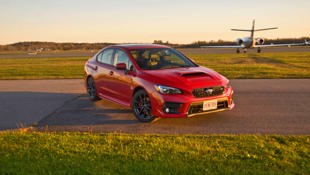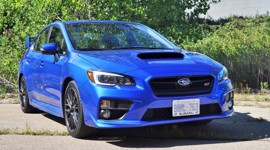 AutoTrader SCORE
AutoTrader SCORE
-
STYLING8/10
-
Safety7/10
-
PRACTICALITY7/10
-
USER-FRIENDLINESS7/10
-
FEATURES7/10
-
POWER8/10
-
COMFORT7/10
-
DRIVING FEEL7/10
-
FUEL ECONOMY6/10
-
VALUE7/10
It sure didn’t take long. Roughly ten minutes after pulling out of the Subaru lot came the first drive-by. A splay-footed Civic Si with shopping-cart wing whooshed past in an uproarious jumble of cherry-bomb flatulence and thudding bass, then executed a painfully slurred downshift to nip in front just before the on-ramp. With a big sigh, I dropped back, giving him plenty of room for whatever stupid manoeuvre came next. Fortunately, he lost interest and continued onto the highway in search of someone more fun to play with, buzzing four-banger fading to a distant drone before disappearing altogether.
Happiest when pushed hard at wide-open throttle.
It never fails. Taking any sport performance car – especially an import – for a test drive is like sending out a pheromone-laced clarion call to the testosterone-driven Fast & Furious set. And this car, the Subaru WRX, is the red-flag-waving target for all their pent-up, Rhys Millen–wannabe aspirations. It’s not the raging 305 hp STI whose legacy was forged on the world rally competition stages, but the enormous hood scoop, quad tailpipes, and bright red paint of my WRX Sport-Tech RS tester made it very difficult to slide low-key under the radar.
The current WRX is a model in transition, having become independent of the Impreza in 2015. Its completely overhauled sibling went on to enjoy accolades for its terrific new handling and interior quality. The Impreza was the first recipient of Subaru’s new Global architecture – the platform that will eventually underpin every vehicle in their portfolio – and WRX fans were left wondering why the automaker’s halo car was overlooked. Rumours abounded; particularly after the Tokyo Motor Show unveiling of the Viziv Performance Concept which Subaru insisted was not the new WRX.
While the concept is undoubtedly a portent of WRXs to come, there’s no guarantee that all of its dramatically chiselled edges will make it to production. The next-gen WRX will reportedly arrive in 2020 and will probably include a hybrid powertrain, and if the “Tourer” edition of the Viziv concept unveiled in Geneva is any indication, we may also see the return of the wagon or hatchback.
Meanwhile, the WRX and STI received a few minor updates for 2018, including revised suspension, a new front bumper, reworked headlights and fog lamps, and exclusive wheels for Sport-Tech trims. Compared to the more upscale new Impreza, the cabin is a bit dated with an abundance of hard plastic. There’s a revised connectivity interface, but Apple CarPlay and Android Auto, available in the Impreza, are notably absent.
Otherwise, everything else is mostly a carryover from the previous model.
Basically, the WRX comes standard with all of the important performance and handling goodies, and the trim levels layer on comfort – and in the case of CVT-equipped models, safety technology. Every WRX comes with a turbocharged 2.0L four-cylinder boxer engine producing 268 hp and 258 lb-ft of torque, mated to symmetrical full-time all-wheel drive. A six-speed manual gearbox is standard, with a continuously variable transmission and paddle shifters as an option. Sport-tuned suspension, aluminum pedals, 6.2-inch infotainment system, USB, Bluetooth, 5.9-inch dash-located multi-function display, heated front seats, rear-view camera, and automatic climate control round off the standard features list.
My tester is a loaded Sport-Tech trim with 18-inch black alloy wheels, STI performance exhaust, keyless push-button start, and an aluminum short shifter with leather boot. A discreet little trunk lid number puts a tidy finish on the rear end – you’ll need to move up to an STI Sport-Tech if you absolutely have to have a Boeing-esque wing.
An optional RS Package finishes it off for $2,300, and adds leather and ultra-suede Recaro sport seats, upgraded Jurid brake pads and red-painted callipers. Because it’s equipped with a six-speed manual, Subaru’s EyeSight safety package (pre-collision braking, pre-collision throttle management, lane departure and sway warning with lane assist, and adaptive cruise control) isn’t available – it only works with CVT-equipped models.
With its prominent hood scoop, angry face, and large air intakes, this car looks and feels aggressive – from head on anyway. The rear view is a bit bland and could use a set of muscular haunches more befitting its character. The car is at its happiest when pushed hard at wide-open throttle. Brash and raucous, it’s all gnashing gears, and barking exhaust with seemingly little grace or refinement. But a few simple upgrades point to an effort to make it easier to live with.
The cabin is a quieter place thanks to more extensive insulation and sound-deadening, and therefore less road and tire noise are evident. Rear passengers now get a pull-down armrest. One small but noteworthy detail is the addition of integrated roof rack brackets – making it much easier to carry bicycles, skis, and camping or travel gear. Three more horsepower and 14 extra pound feet of torque help offset the resultant 50 lb weight gain.
Energuide Canada official fuel ratings for the manual-equipped WRX are 11.3 L/100 km city and 8.5 highway with a combined rating of 10.0 L/100 km. During a week of mixed driving, I averaged 8.9 L/100 km.
The 10-way Recaro seats are comfortable and grippy and not as overtly bolstered as those in the Focus ST – whether that’s good or bad comes down to personal taste.
A leather-wrapped, flat-bottomed wheel looks great and feels fat and grippy. Steering is quick and delivers a decent amount of feedback. It may not have the locking centre diff of the STI, but the WRX’s brake-based active torque-vectoring system makes it a heck of a lot of fun to hit a curvy on-ramp. Selectively applying modulated braking to the inner front wheel, the system helps the car rotate around corners without plowing straight ahead into understeer.
There’s less play in the short shifter now thanks to revised transmission linkage, but it’s fairly notchy and the long throws make it difficult to be smooth. In addition, the long clutch engagement, and juxtaposition of pedals with the invasive transmission tunnel made it rather challenging to execute a smooth heel-and-toe downshift. The turbocharged boxer four is powerful but the discernible lag requires quite a bit of downshifting to access the power band while waiting for the turbo to spool. It’s a lot of work to drive a twisty road with plenty of curves; auto-crossers and track-day enthusiasts had better love shifting gears. On the bright side – they’ll be far too busy to text and drive.
Braking is good, but it’s important to note that the RS package’s Jurid brake upgrade refers to pads only – the rotors and callipers are stock WRX parts with a red coat of paint. STI models, on the other hand, boast six piston Brembo callipers up front, two-piston in the rear, and large, drilled rotors.
Overall, the Subaru WRX is an engaging sports sedan, particularly for those who love a busy drivetrain and enjoy doing all the shifting themselves. It’s athletic and fun, if a bit unrefined. But a base STI starts at $39,495, and my Sport-Tech with RS package tester rings in at $38,795. If your primary focus is performance then the STI is the better bargain. At those prices, the WRX is edging into high performance territory occupied by the VW Golf R, the Civic Type R, and the Focus RS.
Or, save your money, forgo the Sport-Tech’s fancy sound system and extra connectivity tech, forget the RS package which is essentially $2,300 worth of seats and wheels, and opt for the $33,195 WRX Sport trim.
| Engine Displacement | 2.0L |
|---|---|
| Engine Cylinders | H4 |
| Peak Horsepower | 268 hp @ 5,600 rpm |
| Peak Torque | 258 lb-ft @ 2,000–5,200 rpm |
| Fuel Economy | 11.3/8.5/10.0 L/100 km city/hwy/cmb |
| Cargo Space | 340 L |
| Model Tested | 2018 Subaru WRX Sport-Tech with Optional RS Package |
| Base Price | $36,495 |
| A/C Tax | $100 |
| Destination Fee | $1,650 |
| Price as Tested | $40,545 |
|
Optional Equipment
$2,300 – RS Package (leather and suede Recaro sport seats, upgraded brake pads, red-painted brake callipers) $2,300
|
|













































